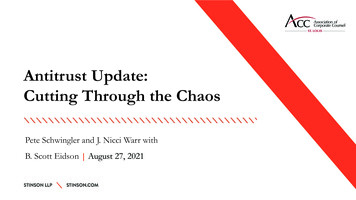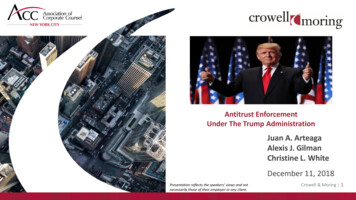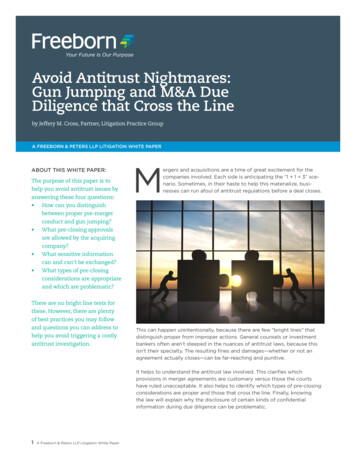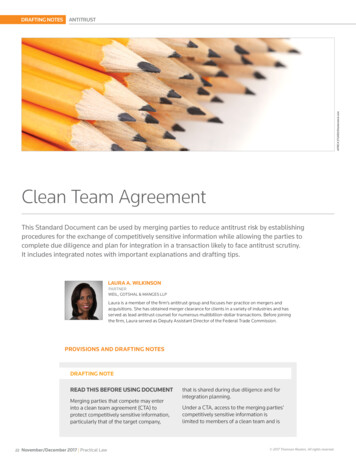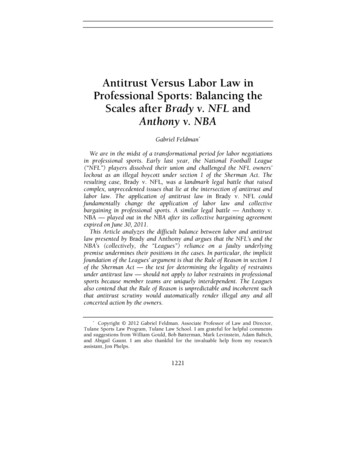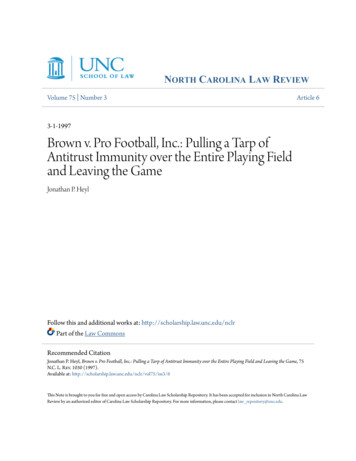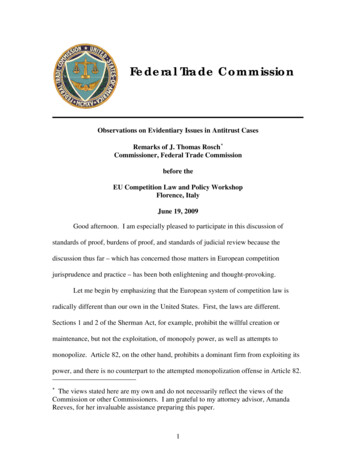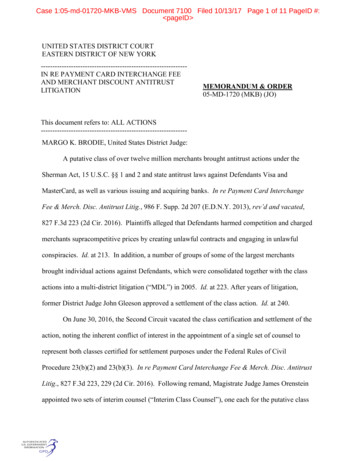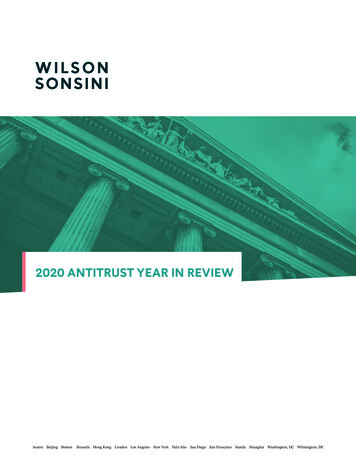
Transcription
2020 ANTITRUST YEAR IN REVIEWAustin Beijing BostonBrussels Hong Kong London Los Angeles New York Palo Alto San Diego San Francisco Seattle Shanghai Washington, DC Wilmington, DE
Wilson Sonsini 2020 Antitrust Year in ReviewTable of ContentsIntroduction.1Merger Enforcement.2Guidance Galore: New Guidelines and HSR Rule Interpretation.2Vertical Merger Guidelines.2Merger Remedies Guidelines.2Changes in HSR Interpretation.3Spotlight on Efficiencies Defenses.3T-Mobile/Sprint.3Peabody Energy/Arch Resources.3Traditional Merger Enforcement. 4FTC’s Winning Streak Ends. 4Both Agencies Bring Hospital Merger Challenges. 4Acquisitions of Nascent Competitors. 4Unusual Actions.5Consummated Merger Challenges.5The Historic Novelis/Aleris Arbitration. 6International Mergers. 6Spotlight on Data (Again). 6EC’s Merger Review Under Judicial Scrutiny. 6Ramped-Up Enforcement in the UK: Redefining “Voluntary”. 6The UK: A Deal Graveyard?.7Brexit and Its Impact on Global Deals.7Agency Investigations.7U.S. Enforcement Agency Collaboration and Disagreement.7Collaboration Between the Federal Agencies.7FTC and DOJ Clash at Intersection of Antitrust and IP. 9Federal Trade Commission .10Clarification of Authority to Seek Monetary Remedies.10Decisions Continued to Show Notable Party-Line Split.10Continued Emphasis on the Pharmaceutical Sector. 11Department of Justice. 11
Wilson Sonsini 2020 Antitrust Year in ReviewTable of Contents (cont.)Renewed Focus on Financial Markets. 11Continued Activity on Standard-Setting Organizations and Patent Licensing Issues. 11DOJ Continues Program to Terminate Decades-Old Consent Decrees. 12DOJ Drops California Emissions Standards Investigation.12State Enforcement.12Competition and Collaboration with the Federal Agencies.12Civil Antitrust Enforcement Outside the United States. 13European Union Investigations. 13EU Member State Investigations.14Regulatory Efforts in Europe to Address the Digital Sphere.14Growing Focus on Large Digital Platforms in Asia.15Criminal/Cartel Investigations.15Notable Developments in the DOJ’s Criminal Antitrust Enforcement Program.15Enforcement Priorities and Initiatives.15Administrative Updates.16Legislative Developments.16International Cooperation.16Significant DOJ Investigations and Prosecutions.16Government Procurement. 17Generic Pharmaceuticals. 17Hard Disk Drive Suspension Assemblies.18Air Cargo and Auto Parts Executive Extraditions.18Financial Services: FOREX.18Food and Consumables.18Construction .19Health Care Staffing .19Cartel Enforcement Outside of the U.S. .19European Union and United Kingdom.19Canada. 20South Korea. 20
Wilson Sonsini 2020 Antitrust Year in ReviewTable of Contents (cont.)Japan.21China.21Brazil.21Civil Litigation.22Section 1: Concerted Action.22Political Bias Antitrust Claims Fail to Gain Traction.22Mixed Results in Cases Involving Organizations.22Follow-on Litigation from Cartel Investigations Remains Active.22Section 2: trust Litigation in the Pharmaceutical Industry.25Class Certification. 26Uninjured Plaintiffs as a Bar to Class Certification. 26Use of Averaging.27Civil Litigation in the UK.28Conclusion. 29About Wilson Sonsini’s Antitrust Practice. 30
Wilson Sonsini 2020 Antitrust Year in ReviewIntroductionWilson Sonsini Goodrich & Rosati ispleased to present its 2020 AntitrustYear in Review, which summarizes themost significant antitrust matters anddevelopments of the past year. Antitrustactivity has not slowed down duringthe COVID-19 pandemic and may infact have accelerated. Continuing thetrend of the last several years, antitrustenforcement—both government andprivate—has become an increasinglyprominent part of the public discourse,particularly with respect to technologyand digital platform industries. Moretraditional enforcement has proceededapace as well, with pharmaceuticals,intellectual property licensing, pricefixing and bid-rigging, and nascentcompetitor acquisitions in thespotlight.In this report, we examine the finalyear of antitrust enforcement underthe Trump administration and analyzeactions by both U.S. antitrust agenciesand enforcers in other jurisdictionsaround the world across a range ofmerger review, civil conduct, andcriminal enforcement matters. Themergers chapter highlights a rangeof new guidance issued by U.S.agencies this year, developments inthe treatment of efficiencies in mergeranalysis, and the growing importanceof the UK Competition and MarketsAuthority in merger clearance. Theagency investigations chapter notescontinued areas of cooperation andcontention between U.S. agencies anddiscusses the priorities of U.S. enforcers(federal and state) and non-U.S.enforcers (focusing particularly on theEuropean Commission and EU memberstates). The criminal enforcement andcartel chapter provides updates on theDepartment of Justice’s enforcement1agenda and leniency program. Wealso describe recent actions in otherjurisdictions, including the EU, UK,Canada, South Korea, Japan, China,and Brazil. This report concludeswith an update on private antitrustlitigation, with particular emphasison developments in pharmaceuticalcases and the increasingly critical classcertification process.We hope you find our 2020 AntitrustYear in Review to be a useful resource.As always, should you have anyquestions or comments on any ofthe matters, trends, or controversiesdiscussed in the report, please contactyour regular Wilson Sonsini attorneyor any member of the firm’s antitrustpractice.
Wilson Sonsini 2020 Antitrust Year in ReviewMergerEnforcementGuidance Galore: NewGuidelines and HSR RuleInterpretationThe year 2020 was an eventful one formerger review and enforcement aroundthe world. In the United States, theU.S. Department of Justice (DOJ) andthe Federal Trade Commission (FTC)published new guidance regardingvertical merger enforcement, mergerremedies, and Hart-Scott-Rodino (HSR)filing requirements. The agencies, alongwith their state-level counterparts, hadpacked merger enforcement agendas.The challenges to T-Mobile/Sprint andPeabody Energy/Arch Resources put aspotlight on efficiencies defenses. Moregenerally, the agencies continued tobring traditional merger enforcementcases, focusing on both acquisitionsthat increase concentration in alreadyconcentrated markets and acquisitionsof nascent competitors. That said, theFTC did bring two novel actions againstconsummated mergers, while the DOJused its authority to resolve a matter inarbitration—a first for the agency.Vertical Merger GuidelinesInternationally, merger enforcerscontinued to closely review competitiveeffects arising from merging data ordata collection resources. The EuropeanCommission saw increased judicialscrutiny of its merger review program,while European enforcers continuedto bring tough sanctions againstprocedural breaches. Finally, the UnitedKingdom’s Competition and MarketsAuthority continued to increase itsjurisdictional reach and to zealouslychallenge global deals—a trend that isonly likely to continue as the Brexittransition period ends.In June 2020, the DOJ and the FTCreleased the final version of the longawaited update to the joint VerticalMerger Guidelines, which were lastissued in 1984.1 Recent enforcementactivity—such as AT&T/Time Warner andStaples/Essendant—has exposed deeprifts on key questions of legal doctrineand economic analysis both in theantitrust bar and between and withinenforcement agencies.For example, the new guidelines aresilent on the topic of remedies forvertical mergers because of disagreementbetween the agencies. The FTC has beenwilling to accept behavioral remediessuch as firewalls. The DOJ, on the otherhand, has been far more critical ofbehavioral remedies, recently stating inits Merger Guidelines Manual (discussedbelow) that “no matter how well crafted,the risk of collaboration in spite of thefirewall is great.”2 The FTC itself wassharply divided along party lines on thenew Vertical Merger Guidelines. BothDemocratic commissioners dissentedfrom the vote adopting the guidelines,criticizing them for overemphasizing thepotential benefits of vertical mergers andfailing to consider alternative theories ofharm.3The new Vertical Merger Guidelines layout the following key principles: Market definition, market shares,and concentration. The agencieswill identify a relevant market andone or more “related products,”meaning a product that is suppliedor controlled by the merged firm2and is positioned vertically or iscomplementary to the products andservices in the relevant market.4Unlike horizontal mergers, theagencies cannot use changes inconcentration as a screen forcompetitive effects. Anticompetitive effects. Theguidelines recognize that verticalmergers can harm competitionby raising rivals’ costs, causingforeclosure,5 increasing thelikelihood of post-mergercoordination,6 or facilitating accessto sensitive business informationabout its upstream or downstreamrivals that was unavailable to itbefore the merger.7 Procompetitive effects. Theguidelines also recognize thatvertical mergers can generateefficiencies that benefitcompetition and consumers,8such as through elimination ofdouble marginalization (EDM).This efficiency—unique to verticalmergers—results from the mergedfirm gaining access to an upstreaminput at cost and avoiding themargin that would be imposed by aseparate upstream input provider.9Merger Remedies GuidelinesIn September 2020, the DOJ issued anupdated Merger Remedies Manual,which lays out the agency’s frameworkfor structuring and implementing reliefin merger cases short of a full-stopinjunction.10 Key aspects of the newManual include: Structural versus behavioralremedies. The DOJ furtherunderscored recent emphasis on itspreference for structural remediesinvolving the sale of businesses orassets by the merging firms overconduct remedies restraining the
Wilson Sonsini 2020 Antitrust Year in Reviewmerged firm’s business conduct orpricing authority.11 The Manualstates that structural remediesare “clean and certain, effective,and avoid ongoing governmententanglement in the market,”12while conduct remedies areonly appropriate in very limitedsituations.13 Consent enforcement. The DOJis renewing its focus on enforcingobligations against merging partiesin consent decrees. The Manualsets out new standard provisionsthat must be included in consentdecrees and highlights the role ofthe newly created Office of DecreeEnforcement and Compliance(ODEC) to oversee complianceefforts across the DOJ.14Changes in HSR InterpretationIn September 2020, the FTC announcedan important change in its interpretationof the HSR Rules’ treatment of specialdividends.15 HSR Rule 801.90 states thatmerging parties cannot use a transactionstructure for the purpose of avoiding ordelaying their filing obligation. FTC staffdetermines whether avoidance or delaywas the objective by applying a “but for”test.16 If the transaction’s structure wasmotivated by some benefit from avoidingor delaying HSR filing, then it is an“avoidance device” under the rule.A 2003 informal interpretationcategorically excluded special dividendsfrom consideration as an avoidancedevice, allowing parties to avoidfiling by using special dividends toget under the HSR size-of-personor size-of-transaction thresholds. InSeptember 2020, the FTC withdrewthis interpretation. Going forward,FTC staff will evaluate specialdividends more holistically, applyingthe aforementioned “but for” test todetermine whether the parties structuredthe deal to avoid or delay an HSR filing.17Spotlight on EfficienciesDefensesTwo major enforcement litigations in2020 put a spotlight on uncertaintiesin how efficiencies should be evaluatedand balanced in merger cases. Both theT-Mobile/Sprint and Peabody Energy/ArchResources cases went to trial this year,and both defenses were based in part onthe assertion of substantial efficienciesarising from the combinations. T-Mobileand Sprint secured a win based in parton those efficiencies, but the courtalso relied on other market structureevidence. The court dismissed theefficiencies in Peabody Energy/ArchResources and forbade the joint venture.While these cases breathed some lifeinto efficiencies defenses, they showthat efficiencies, standing alone, remainunlikely to carry the day.evidencethattheefficiencies arising fromthe Proposed Merger willcause New T-Mobile tocompete more vigorouslywith its rivals in the market[] evidencethatSprint is a weakenedcompetitorthatisnot likely to continuecompetingvigorouslyin the market[] andevidence that the DOJ andFCC collective efforts toestablish DISH as a newvigorous competitor in the market[] ameliorate[s]any remaining concern ofanticompetitiveeffect.20The opinion makes it clear that, whileefficiencies were an important factor,approval of the merger also hinged onevidence of an effective new competitorentering the market and Sprint’s waningcompetitive significance.T-Mobile/SprintPeabody Energy/Arch ResourcesOn February 11, 2020, Judge Marrero ofthe U.S. District Court for the SouthernDistrict of New York dismissed achallenge to the proposed mergerbetween T-Mobile and Sprint broughtby a group of state attorneys general(the deal received DOJ and FederalCommunications Commission (FCC)conditional clearance while the suit waspending).18 Judge Marrero concludedthat the plaintiffs “ha[d] established aninitial presumption that, by reason ofhigher concentration in fewer firms inthe relevant market, and New T-Mobile’smuch larger market share, the effect ofthe Proposed Merger would be likelyanticompetitive.”19 However, JudgeMarrero further ruled that T-Mobileand Sprint had “satisfied their burden ofrebuttal” by providing:3On September 29, 2020, Judge Pitlyk ofthe U.S. District Court for the EasternDistrict of Missouri considered aproposed joint venture between twolarge coal mining facilities—PeabodyEnergy and Arch Resources.21 Thedefendants argued that the jointventure combining Peabody’s NARMmine with Arch’s neighboring BlackThunder mine would unlock efficiencies,“strengthening coal’s competitivenessagainst natural gas and renewables”—sources of energy that the FTC hadexcluded from the relevant market.22The court agreed that the joint venturewould “clearly make possible substantialefficiencies,”23 but held that the FTC’sproposed market was properly drawnand that the efficiencies, even if fullycredited, “would not offset the likely
Wilson Sonsini 2020 Antitrust Year in Reviewcompetitive harm” in the FTC’s coalbased relevant market.24Traditional MergerEnforcementMerger review statistics for 2020 havenot yet been published,25 but the FTCand DOJ have continued to bringenforcement actions, focusing particularly on both acquisitions that increaseconcentration in already concentratedmarkets and acquisitions of nascentcompetitors.FTC’s Winning Streak EndsNotably, the FTC’s seven-case winningstreak of litigated merger challengescame to an end in 2020 when the U.S.District Court for the District of Columbia denied the FTC’s request for a preliminary injunction to prevent EvonikIndustries from acquiring PeroxyChemHoldings. The FTC proposed a productmarket “for the sale of standard, specialty, and pre-electronics grade hydrogenperoxide.”26 Deviating from the standardpractice of defining product marketsbased on demand-side substitution,the FTC instead relied on evidence ofsupply-side substitutability.27 The courtsoundly rejected the FTC’s relevant market as “ill-conceived”28 and denied theinjunction in part on that ground.29In December, the FTC lost anotherpreliminary injunction, this timein a hospital merger case. The FTCbrought suit in the Eastern District ofPennsylvania to enjoin Jefferson Health’sproposed acquisition of Albert EinsteinHealthcare pending an administrativetrial on the merits. The court denied theFTC’s request, concluding that the FTC’sproposed geographic markets did notalign with the commercial realities ofproviding healthcare in the Philadelphiaregion.30 The court found that the FTCfailed to carry its burden to show thatinsurers would accept a price increaserather than turn to hospitals outside ofthe alleged markets, noting in particularthat insurers’ testimony was conclusoryand not credible.31Both Agencies Bring Hospital MergerChallengesThe FTC has had primary responsibilityover hospital mergers since at least themid-2000s, but both the FTC and DOJare currently litigating hospital mergercases. The FTC filed three administrativecomplaints in 2020. As noted above,the FTC failed to secure a preliminaryinjunction in its challenge to JeffersonHealth’s proposed acquisition of AlbertEinstein Healthcare. Two other suits arepending, one seeking to block MethodistLe Bonheur Healthcare’s acquisition oftwo Memphis-area hospitals owned byTenet Healthcare and a second seekingto block Hackensack Meridian Health’sacquisition of hospitals from EnglewoodHealthcare Foundation in BergenCounty, New Jersey.32Both complaints follow the typicalpattern for hospital mergers. TheMethodist Le Bonheur Healthcarecomplaint alleges that the acquisition oftwo Saint Francis hospitals in Memphiswill reduce the number of providersof general acute care (GAC) inpatienthospital services in the Memphisarea from four to three, resulting inMethodist Le Bonheur Healthcarecontrolling over 50 percent of the marketfor GAC inpatient hospital servicesin the Memphis area.33 Similarly, theHackensack Meridian Health complaintalleges that the deal would consolidatethree of the six GAC hospitals in BergenCounty, accounting for roughly halfof GAC services in the area.34 ChiefAdministrative Law Judge D. MichaelChappell has been appointed to preside4over both cases, with trial for MethodistLe Bonheur Healthcare set to begin onMay 18, 2021.35The DOJ’s challenge to GeisingerHealth’s 100 million acquisition ofa 30 percent interest in EvangelicalCommunity Hospital is somewhatunusual because minority acquisitionsare rarely litigated.36 The DOJ allegedthe arrangement was intended to dodgeantitrust scrutiny, citing the parties’documents discussing previous attemptsto merge. The DOJ further asserted thatthe parties’ collaboration agreement“fundamentally alter[s] their relationshipas competitors and curtail[s] theirincentives to compete independently forpatients.”37 Litigation is ongoing.Acquisitions of Nascent CompetitorsIn 2020, the FTC and DOJ havecontinued to challenge mergers theybelieve would eliminate a nascentcompetitor, especially in technologysectors. A nascent or potentialcompetition theory of harm appeared infive of the FTC’s 22 merger enforcementactions and three of the DOJ’s 10 mergerenforcement actions this year.38On February 3, 2020, the FTC filed anadministrative complaint challengingthe merger of Edgewell PersonalCare Company, a consumer productscompany that supplies multiple razorbrands—including the second-largestbrand, Schick—and Harry’s, Inc., anonline “direct-to-consumer” supplierof razors that recently expanded itsofferings to brick-and-mortar retailers.39Despite Harry’s modest market share,the FTC concluded that Harry’sfuture competitive significance wasunderstated. The complaint cites anEdgewell investor deck referring toHarry’s as “one of the most successfulchallenger brands ever built”40 and
Wilson Sonsini 2020 Antitrust Year in Reviewalleges that Harry’s entry at Target andWalmart “ended the long-standingpractice of reciprocal price increases byGillette and Edgewell,” resulting in pricereductions and/or increased promotionalspend by Proctor & Gamble (P&G) andEdgewell.41 Harry’s introduction of theFlamingo brand for women in October2018 allegedly also prompted reducedprices and aggressive promotions fromboth Edgewell and P&G.42 One weekafter the complaint was filed, Edgewellterminated the merger agreement.Harry’s has threatened litigation againstEdgewell, though it appears that no casehas yet been filed.43Eleven months later, the FTC filed anadministrative complaint challenginganother proposed transaction in therazor industry—P&G’s acquisition ofBillie, Inc.44 Similar to Edgewell/Harry’s,the FTC alleged that Billie, a direct-toconsumer seller of women’s razors andbody care products that launched in2017, is a nascent, but rapidly growing,head-to-head competitor of P&G’s.According to the FTC, competition fromBillie spurred P&G to introduce its owndirect-to-consumer website promotingits Venus-brand razors for women.The FTC also noted that Billie’s rapidgrowth was likely to expand into brickand-mortar stores, further challengingP&G’s position as the market leader.The administrative trial is set to beginon June 22, 2021, and, in the interim, theFTC will seek a temporary restrainingorder and preliminary injunction infederal court.Nascent competition was also atthe center of the DOJ’s challenge toSabre Corporation’s acquisition ofFarelogix. The DOJ asserted at trialthat both current and forward-lookingmarket share estimates understate thecompetitive significance of Farelogixbecause they “do not account for theleverage that airlines gain from havingFarelogix’s Open Connect availableas an alternative when negotiatingcontract terms with Sabre.”45 The DOJalso presented evidence that Sabre hada history of engaging in anticompetitivetactics designed to undermine anddelay the adoption of Farelogix’stechnology.46 The district courtacknowledged that Farelogix had beena “pioneering innovator and disrupto
intellectual property licensing, price-fixing and bid-rigging, and nascent competitor acquisitions in the spotlight. In this report, we examine the final year of antitrust enforcement under the Trump administration and analyze actions by both U.S. antitrust agencies and enforcers in other jurisdictions around the world across a range of
